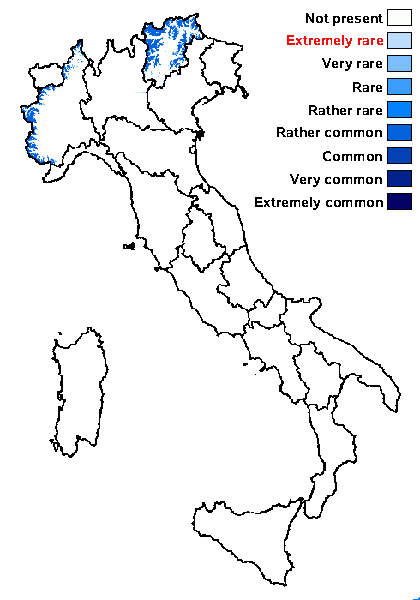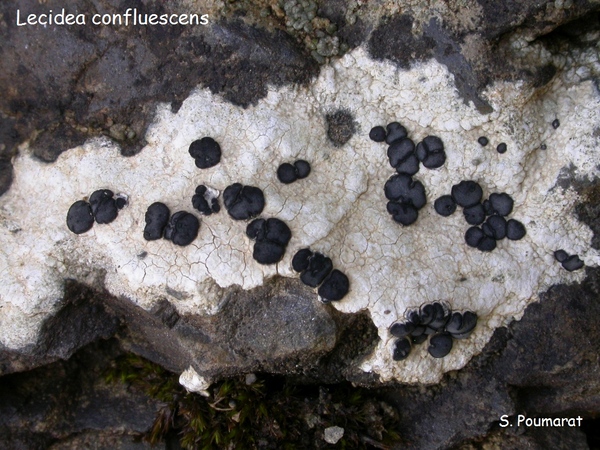Lecidea confluescens Nyl.
Flora, 57: 12, 1874.
Synonyms: Lecidea venustula Arnold
Distribution: N - TAA (Nascimbene & al. 2022), Piem (TSB 33703).
Description: Thallus crustose, episubstratic, 0.2-1.2 mm thick, chalky white to bluish white, of 0.2-1.5 mm wide, contiguous areoles, rarely delimited by a very thin dark prothallus. Medulla white, I+ blue. Apothecia lecideine, adnate, 0.3-1.2(-2) mm across, dull black, epruinose, with a flat to slightly convex, not umbonate disc, and a rather thin, persistent, raised proper margin. Proper exciple black along the thin outer rim, colourless within, K-, C-; epithecium green-black to brown-black, 10-20 µm high; hymenium pale greenish to colourless, (50-)60-75 µm high; paraphyses coherent, simple or rarely sparingly branched and anastomosing, 1.5-1.8 µm thick at base, the apical cells 2-2.5 µm wide; hypothecium dark reddish brown, K-, 90-170 µm high. Asci 8-spored, narrowly clavate, thick-walled, with a K/I+ pale blue tholus and a strongly amyloid, thin apical cushion, surrounded by a I+ blue outer layer, Lecidea-type. Ascospores 1-celled (but with a conspicuous plasma bridge and often appearing 2-celled), hyaline, ellipsoid or narrowly ellipsoid, 9-17 x (4-)5-6(-7) µm, thin-walled, not halonate. Photobiont chlorococcoid. Spot tests: thallus K-, C-, KC-, P-, UV-. Chemistry: thallus without lichen substances.Note: on inclined to vertical faces of calciferous rocks, especially lime-containing schists, with optimum above treeline, up to the nival belt; related to L. lapicida, but calcicolous and probably restricted to the Alps where it is rare (Hertel 1995). The world distribution was mapped by Hertel (2006).
Growth form: Crustose
Substrata: rocks
Photobiont: green algae other than Trentepohlia
Reproductive strategy: mainly sexual
Commonnes-rarity: (info)
Alpine belt: rather common
Subalpine belt: very rare
Oromediterranean belt: absent
Montane belt: absent
Submediterranean belt: absent
Padanian area: absent
Humid submediterranean belt: absent
Humid mediterranean belt: absent
Dry mediterranean belt: absent

Predictive model
Herbarium samples
Growth form: Crustose
Substrata: rocks
Photobiont: green algae other than Trentepohlia
Reproductive strategy: mainly sexual
Commonnes-rarity: (info)
Alpine belt: rather common
Subalpine belt: very rare
Oromediterranean belt: absent
Montane belt: absent
Submediterranean belt: absent
Padanian area: absent
Humid submediterranean belt: absent
Humid mediterranean belt: absent
Dry mediterranean belt: absent

Predictive model
| Herbarium samples |
 INDEX FUNGORUM
INDEX FUNGORUM
 GBIF
GBIF
 DOLICHENS
DOLICHENS





